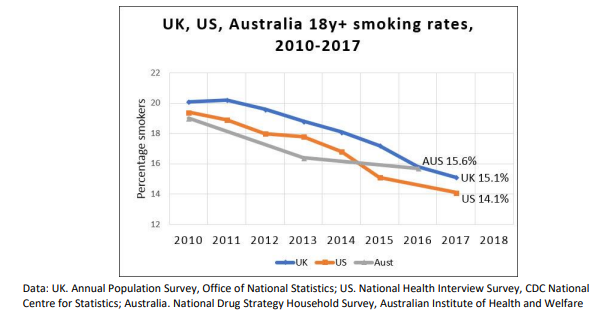Why are Australian physicians so opposed to vaping?
A new report from the Royal Australasian College of Physicians (RACP) acknowledging that ecigarettes can help smokers quit is a welcome shift in policy (1).
However, despite this acknowledgement the Australasian College, which represents Australian and New Zealand medical specialists, does not support their use because of their potential risks.
The recommendation is in direct contrast with a report by the highly respected UK Royal College of Physicians (2) which concluded in 2016 that, in spite of the potential risks, e-cigarettes have ‘huge potential to prevent death and disability.’ The UK experts recommend that 'in the interests of public health it is important to promote the use of e-cigarettes…as widely as possible as a substitute for smoking'.
The UK Royal College of Physicians is an independent charity representing 34,000 physicians worldwide.
According to the Australian Tobacco Harm Reduction Association (ATHRA) Chairman, Associate Professor Colin Mendelsohn the RACP has failed Australian smokers.
“Millions of smokers have quit overseas by switching to vaping. (3) Smoking rates in many countries which allow vaping have tumbled, while stalling in Australia. (4) [See graph on page 2] These lifesaving products should also be available to Australian smokers,” Dr Mendelsohn said.
“The RACP's main concerns are that vaping will renormalise smoking and act as a gateway to smoking for young people. However, the UK review found that these concerns have not eventuated.”
The UK analysis found that 'the available evidence to date indicates that e-cigarettes are being used almost exclusively as safer alternatives to smoked tobacco, by confirmed smokers who are trying to reduce harm to themselves or others from smoking, or to quit smoking completely.'
ATHRA board member, Dr Alex Wodak AM said the Australian policy is focussed on the uncertainties around vaping but ignores the huge potential public health benefit.
“Vaping is not risk-free, but according to the UK analysis, long-term use is at least 95% less harmful than smoking,” Dr Wodak said.
“If we wait thirty years until we have definitive proof about long-term safety, many people will die unnecessarily. Up to two out of three Australian smokers will be killed by their habit if they continue to smoke.” (5)
“The reality is that many smokers are unable or unwilling to quit. We should be making it easier to switch from a high-risk to a lower-risk nicotine product, not harder,” he said.
Contact
Associate Professor Colin Mendelsohn
Chairman, Australian Tobacco Harm Reduction Association
School of Public Health and Community Medicine, University of New South Wales, Sydney
M: 0415 976 783 | E: c.mendelsohn@unsw.edu.au
Dr Alex Wodak AM
Board Member, Australian Tobacco Harm Reduction Association
Emeritus Consultant, St Vincent’s Hospital Alcohol and Drug Service, Sydney
M: 0416 143 823 | E: alex.wodak@gmail.com
What is ATHRA?
Australian Tobacco Harm Reduction Association (ATHRA) is a health promotion charity registered with the Australian Charities and Not-for-profits Commission. ATHRA was established to raise awareness of evidence-based, safer alternatives to smoking such as vaping and to educate the public and health professionals about them. Website: https://athra.org.au
Data: UK. Annual Population Survey, Office of National Statistics; US. National Health Interview Survey, CDC National Centre for Statistics; Australia. National Drug Strategy Household Survey, Australian Institute of Health and Welfare

References
1. Royal Australasian College of Physicians. Policy on e-cigarettes. May 2018.Available at: https://www.racp.edu.au/docs/default-source/advocacy-library/policy-on-electronic-cigarettes.pdf Accessed 24 June 2018
2. Royal College of Physicians. Nicotine without smoke: Tobacco harm reduction. London: RCP. 2016.Available at: https://www.rcplondon.ac.uk/projects/outputs/nicotine-without-smoke-tobacco-harm-reduction-0 Accessed 24 June 2018
3. Farsalinos KE, Poulas K, Voudris V, Le Houezec J. Electronic cigarette use in the European Union: analysis of a representative sample of 27 460 Europeans from 28 countries. Addiction (Abingdon, England). 2016;111(11):2032-40.
4. Australian Institute of Health and Welfare. National Drug Strategy Household Survey (NDSHS) 2016: detailed findings. Drug Statistics series no. 31. Cat. no. PHE 214. Canberra: AIHW, 2017. Available at: https://www.aihw.gov.au/getmedia/15db8c15-7062-4cde-bfa4-3c2079f30af3/21028.pdf.aspx?inline=true. Accessed 24 June 2018
5. Banks E, Joshy G, Weber MF, Liu B, Grenfell R, Egger S, et al. Tobacco smoking and all-cause mortality in a large Australian cohort study: findings from a mature epidemic with current low smoking prevalence. BMC medicine. 2015;13:38.